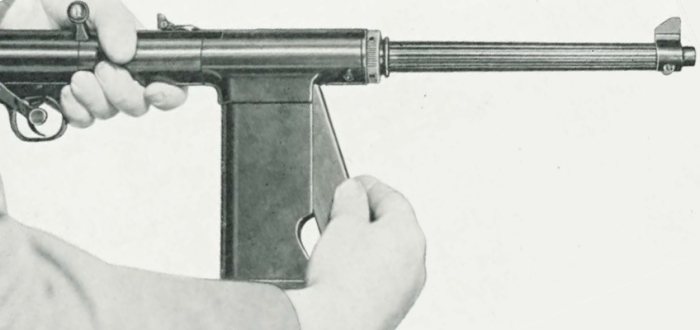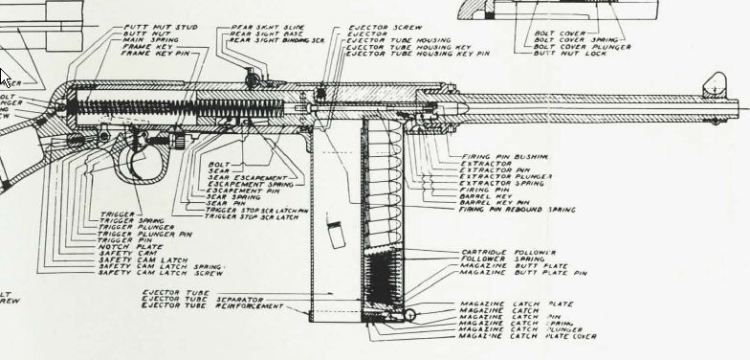
S&W Light Rifle Model 1940 Mk.1

S&W Light Rifle Model 1940 Mk.1, with Enfield-made detachable metallic stock

S&W Light Rifle Model 1940 Mk.2

loading magazine into S&W Light Rifle Model 1940 Mk.1

S&W Light Rifle Model 1940 Mk.1, diagram from original manual
Data for S&W Light Rifle Mk.1
|
Caliber |
9×19 Luger |
|
Overall length |
822 mm |
|
Barrel length |
248 mm |
|
Weight, w. empty magazine |
3,9 kg |
|
Magazine capacity |
20 rounds |
The Smith & Wesson (S&W) Light Rifle was developed by famous American small arms manufacturing company Smith & Wesson in 1939 for police and security use, and placed into limited production in 1940, as S&W Light Rifle Model 1940. About 1100 of these rifles were manufactured in two marks, Mk.1 and Mk.2, most of which were delivered to UK in 1940-41. Out of two marks, the Mk.2 is scarcer, as only about 100 of S&W Light Rifle Mk.2 were manufactured before the whole project was dropped. In around 1942 some of the British issue S&W light rifles were fitted with Enfield-made metallic shoulder stocks, to be used by Royal Navy personnel. Service record of the S&W Light Rifle Model 1940 was rather uninspiring, as it was expensive to manufacture, insufficiently durable and not reliable with British-issue 9mm pistol / SMG ammunition. Few of these light rifles survived to this day and are now valuable collector items.
Smith & Wesson (S&W) Light Rifle is a simple blowback operated, semi-automatic only weapon which fires from open bolt. Most of its parts are machined from steel and of intricate shape, making it quite expensive in production. S&W Mk.1 Light Rifles has movable firing pin which is operated by a lever, built into the bolt body. This lever pushes the firing pin forward and out of the bolt face only when bolt is in its forwardmost position. On late production Mk.2 models, firing pin is fixed to the bolt face. Manual safety on S&W Mk.1 Light Rifles consists of a lever, located behind the trigger guard on the right side of the frame. On the Mk.2 Light Rifles safety lever is replaced by rotating sleeve around the receiver, which has a horizontal slot cut for passage of the cocking handle that is rigidly attached to the bolt. Rotation of this sleeve allows locking the bolt either in forward or in rearward (cocked) position. Bolt hold-open (last round stop) device is incorporated into the design. Most unusual feature of the S&W Light Rifle is its magazine housing / ejection chute arrangement. The large magazine housing actually consists of two parts. Front part, which is open at the front, is the magazine housing itself. A 20-round double stack box magazine is inserted here from the front, and locked by a latch at the bottom of the housing. Rear part of the housing is actually an ejection chute and is open at the bottom. Upon discharge, bolt carries the spent case rearwards and over the magazine, until it is ejected downward into the ejection chute and out of its base. This arrangement makes weapon unnecessarily heavy, and makes jam clearing procedures very complicated and time-consuming due to the need to partially disassemble the jammed weapon.
Standard stock consists of a wooden shoulder piece with semi-pistol grip. Some of the Smith & Wesson (S&W) Light Rifles used by Royal Navy were fitted with aluminum pistol grip and detachable steel shoulder stocks, developed by Royal Small Arms Factory at Enfield. Standard iron sights were also of unnecessarily complicated design, with micrometer click-adjustable U-notch rear sight, adjustable for range between 50 and 400 yards.